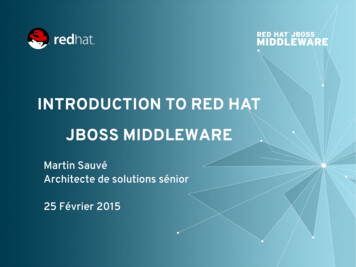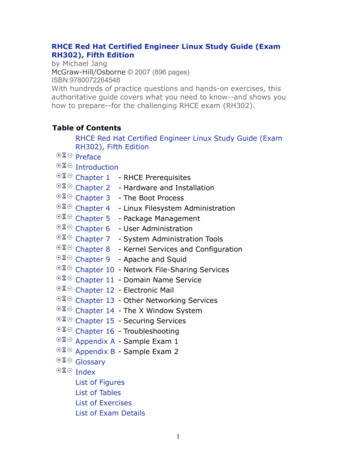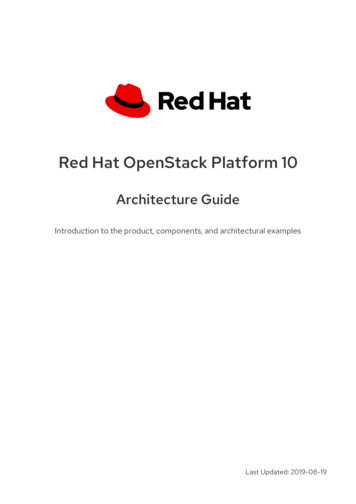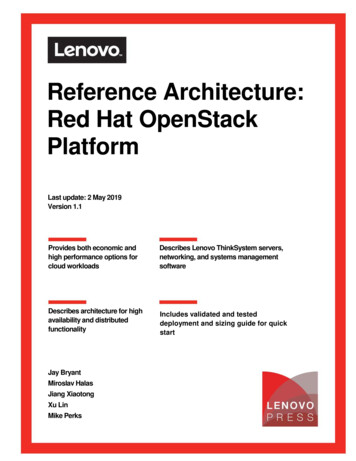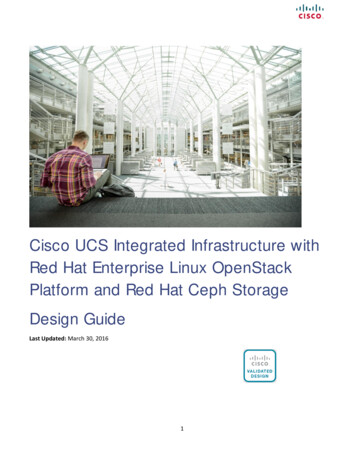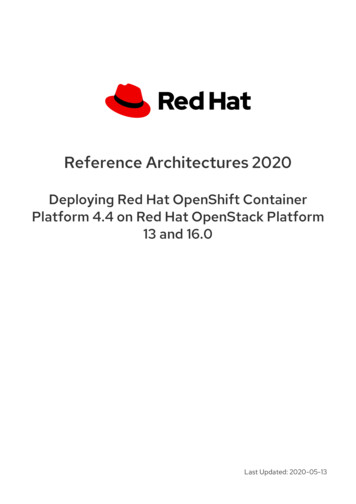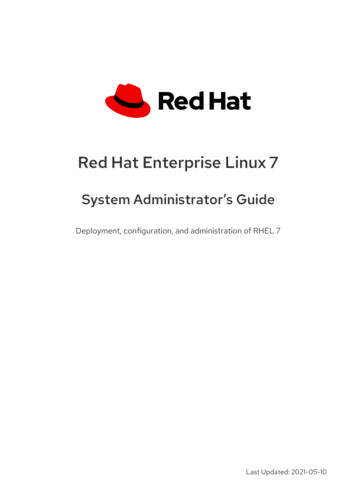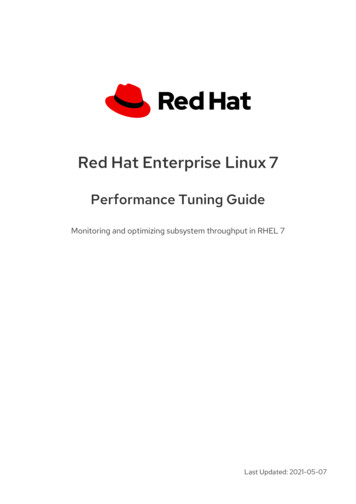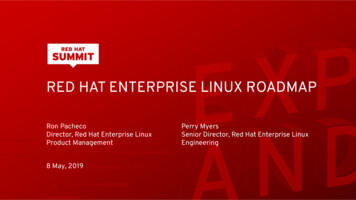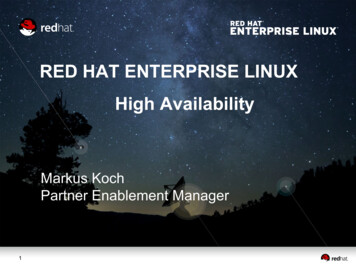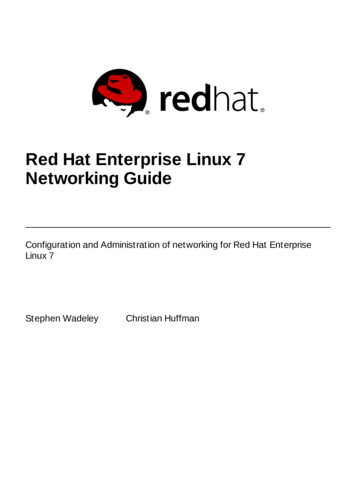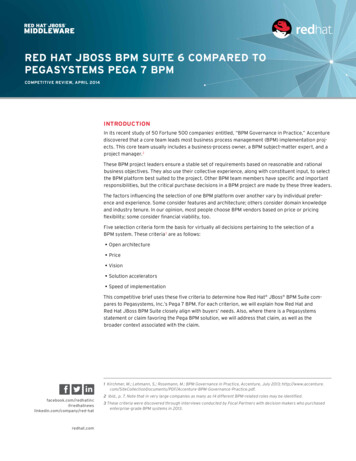
Transcription
RED HAT JBOSS BPM SUITE 6 COMPARED TOPEGASYSTEMS PEGA 7 BPMCOMPETITIVE REVIEW, APRIL 2014INTRODUCTIONIn its recent study of 50 Fortune 500 companies1 entitled, “BPM Governance in Practice,” Accenturediscovered that a core team leads most business process management (BPM) implementation projects. This core team usually includes a business-process owner, a BPM subject-matter expert, and aproject manager. 2These BPM project leaders ensure a stable set of requirements based on reasonable and rationalbusiness objectives. They also use their collective experience, along with constituent input, to selectthe BPM platform best suited to the project. Other BPM team members have specific and importantresponsibilities, but the critical purchase decisions in a BPM project are made by these three leaders.The factors influencing the selection of one BPM platform over another vary by individual preference and experience. Some consider features and architecture; others consider domain knowledgeand industry tenure. In our opinion, most people choose BPM vendors based on price or pricingflexibility; some consider financial viability, too.Five selection criteria form the basis for virtually all decisions pertaining to the selection of aBPM system. These criteria3 are as follows: Open architecture Price Vision Solution accelerators Speed of implementationThis competitive brief uses these five criteria to determine how Red Hat JBoss BPM Suite compares to Pegasystems, Inc.’s Pega 7 BPM. For each criterion, we will explain how Red Hat andRed Hat JBoss BPM Suite closely align with buyers’ needs. Also, where there is a Pegasystemsstatement or claim favoring the Pega BPM solution, we will address that claim, as well as thebroader context associated with the claim.1 Kirchmer, M.; Lehmann, S.; Rosemann, M.: BPM Governance in Practice, Accenture, July 2013; atredhat.com2 Ibid., p. 7. Note that in very large companies as many as 14 different BPM-related roles may be identified.3 These criteria were discovered through interviews conducted by Focal Partners with decision-makers who purchasedenterprise-grade BPM systems in 2013.
OPEN ARCHITECTUREOpen architecture is often used to describe systems with public specifications. Open architecturescan make adding, upgrading, or swapping components easy4. An open architecture allows buyersto integrate emerging technology, employ commodity infrastructure, and lower operation andmaintenance costs. 5As an open source BPM system, there is nothing that is not public about Red Hat JBoss BPM Suite.Indeed, the core is a lightweight, extensible workflow engine written in pure Java. All components ofRed Hat JBoss BPM Suite are discussed and developed in an open forum, leading to vigorous debateabout incorporating new technologies on common hardware components. Buyers get the benefit ofthese diverse perspectives when adopting Red Hat JBoss BPM Suite.Furthermore, Red Hat JBoss BPM Suite allows users to execute business processes using the latestBPMN 2.06 specification. According to information gathered from multiple internet sites, two-thirdsof the 33 BPM solutions we examined claim support for BPMN adhere to version 2.0 without qualification. Chief among those vendors is Red Hat.Red Hat JBoss BPM Suite allowsyou to use BPMN 2.0Red Hat JBoss BPM Suite relies on BPMN 2.0 as the language for expressing business processes.With BPMN 2.0, users can model the entire life cycle of a business process (from authoring throughexecution to monitoring and management) and execute that model in Red Hat JBoss BPM Suitewithout modification.Consider Pegasystems’ claim about the openness of its Pega BPM product:“The foundation of Pegasystem’s BPM technology is a robust, “insanely open” architecture thatembraces and exploits industry-standards and best practices, while providing a unified, modeldriven design environment for business analysts and technologists.” 7There is room to challenge Pega BPM’s claims to open architecture, both in its ability to integrateemerging technology and to lower maintenance costs. Consider technology integration, whereForrester Research advises that learning, implementing, and adapting Pegasystems’ complex BPMenvironment takes longer than other BPM systems.8How much effort will it take tofind BPM developers for yourprojects?Then there’s the cost of employing qualified people to maintain and extend a BPM implementation. There are perhaps 10 million Java programmers in the world, and approximately 68% of thosedevelopers use the Eclipse development environment on which Red Hat JBoss BPM Suite tooling isbased.9 If just 1% of those Eclipse-trained developers download and learn to use the Red Hat JBossBPM Suite product, there is a pool of at least 68,000 programmers available to adapt a Red HatJBoss BPM Suite implementation to specific customer needs.4 “Open Architecture.” Wikipedia. Wikimedia Foundation, retrieved 5 Jan. 2014 — http://en.wikipedia.org/wiki/Open architecture.5 Di Leo, Carlo. “Importance of Open Architecture Technology.” Web log post. Double Vision. 15 Oct. 2011. retrieved 07Jan. 2014 — p/importance-of-open-architecture-technology/.6 Business Process Model and Notation, version 2; released January 2011.7 Pegasystems, Inc. Pegasystem’s “Insanely Open” Architecture; Cooper Consulting; retrieved 07 Jan. 2014 — 20Insanely%20Open%20Architecture-2.pdf.8 See dfs/forresterwave bpmste.pdf.9 Potter, Priit. “How Many Java Developers Are There in the World?” Plumbr, 18 July 2012. Web. 30 Nov. 2013 — the-world.redhat.comCOMPETITIVE REVIEWRed Hat JBoss BPM Suite 6 compared to Pegasystems Pega 7 BPM2
Now consider the pool of Pega BPM resources. According to public documents obtained in December2013, Pegasystems has 740 research and development employees and another 651 consulting andcustomer support employees.10 Even if all of those employees were available to work on Pega BPMprojects, that would be just two percent of the estimated number of potential programmers available worldwide to implement and adapt the Red Hat JBoss BPM Suite.11 With so many more qualifiedresources for Red Hat JBoss BPM Suite than Pega BPM, supply and demand principles dictate thatRed Hat JBoss BPM Suite has lower operation and maintenance costs than Pega BPM.Another counterpoint to Pegasystems’ claim to open architecture: Pegasystems does not supportBPMN 2.0 because it claims that BPMN 2.0 is, “ too hard for business.” 12 Instead, Pega BPM contains proprietary extensions (for example, the “stencil” object), in effect creating a proprietary modeling language. Pegasystems justifies this approach because, “.[n]obody has BPMN 100% covered,everyone has customized interpretations of BPMN 2.0.” 13PRICERed Hat JBoss BPM Suite has nosoftware license feesPrice usually refers to licensing and maintenance costs, but it also includes the process by which abuyer and a vendor arrive at mutually agreeable price. Subscription pricing for Red Hat JBoss BPMSuite helps tie Red Hat’s performance (i.e., through upgrades, updates, patches, and fixes) to customer outcomes. If Red Hat fails to meet expectations, customers always have access to the sourcecode and a worldwide community of independent software developers and system integrators whocan provide alternative service options.Pegasystems describes its pricing approach this way:“Pega’s pricing model is to charge by the project based on a program view. Pega provides a rationalapproach to licensing based on scope associated to projects rather than an enterprise toolapplication model.” 14While there is no doubting the truth of this claim, it should be noted that final pricing usually restswith one of Pegasystems’ contracts and negotiation specialists.15 This may lead to customer confusion, where the price given in a proposal by a Pega BPM sales representative could be renegotiatedwith a contracts specialist who has no relationship with the buyer. In one example, a customer, whoasked not to be identified, said it took a year to complete a licensing contract.10 “Form 10-K.” Pegasystems Form 10-K. United States Securities and Exchange Commission, 20 Feb. 2013. Web. 30 Nov.2013 — 119312513067337/d453798d10k.htm.11 In this calculation, we use the total number of Pega BPM developers compared with the estimated 1% of Eclipsedevelopers worldwide (which is 68% of the estimated 10 million Java developers worldwide) that could download theJBoss BPM Suite.12 Stamper, Jason. “Pegasystems Says BPMN 2.0 Is ‘too Hard for Business’” Computer Business Review, 16 May 2011.Web. 30 Dec. 2013 — n-20-is-too-hard-for-business.13 Ibid.14 Weber, Terry. “Response to RFI for MMIS Replacement.” Arkansas Department of Human Services, Web. 08 Jan.2014 — 5 “Senior Contracts And Negotiations Specialist EMEA.” Job Description. Pegasystems, Inc., Web. 10 Jan. 2014 — comCOMPETITIVE REVIEWRed Hat JBoss BPM Suite 6 compared to Pegasystems Pega 7 BPM3
Pegasystems licenses Pega BPM on a usage basis with a license fee for each named user, rule execution, and connection to an external system.16 This means that Pega BPM customers incur extralicense charges for implementations that connect the BPM system with externally facing web sites.This also means that customers could incur extra license charges if a project experiences scopecreep that increases one or more of the Pegasystems pricing factors.VISIONVision is the alignment between a vendor’s product or business strategy and a buyer’s current andfuture needs.17 In business process management, one aspect of vision is process modeling. Red Hatprocess modeling encourages behavior-driven development (BDD), or specification by example. BDDhelps organizations increase speed-to-market, manage expectations across multiple constituents,and develop cost-effective BPM solutions with reduced complexity. BDD brings together subjectmatter experts, testers, and developers through a common vocabulary — all the justifications usuallyascribed to model-driven development (MDD) — without the choke points that MDD introduces into aBPM project. Red Hat’s embrace of BDD is vision with clear and tangible benefits for BPM buyers.Contrast Red Hat’s vision of modeling with Pegasystems’ vision, which skews heavily toward an allmodeling BPM development environment. According to Kerim Akgonul, vice president of ProductManagement at Pegasystems:“Pegasystems’ focus on model-driven development will help companies improve their differentiation,their innovation, and their ability to engage customers effectively and with agility.” 18We consider Pegasystem’s vision for model-driven development (MDD) to be impractical intwo keys areas:191.2.It introduces rigidity into the development process, eliminating control over important executiondetails such as user-interface design and flow.Models are only flexible where Pega BPM allows such flexibility, not necessarily where the BPMimplementation requires it.These conditions can impose serious constraints on BPM buyers, who seek to maximize flexibility inBPM solutions. Flexibility is key to handling unforeseen changes in behavior requirements, operatingenvironments, and corporate expectations. Therefore, we find Pega BPM’s heavy reliance on modeling to be out of phase with buyer expectations.16 AVIO Consulting. BPM Product Analysis; AVIO Consulting, LLC, Aug. 2013. Web. 08 Jan. 2014; p. 20 — cle-bpm-vs-pega-comparison-1998344.pdf.17 Derived from Gartner’s definition of “Completeness of Vision”. See Magic Quadrants and MarketScopes: How GartnerEvaluates Vendors Within a Market. Gartner, Inc.; 22 Jan. 2008. Web. 05 Jan. 2014 — https://www.gartner.com/doc/486094.18 Pegasystems, Inc. Pegasystems to Showcase ‘Better Business Software’ at Gartner Symposium ITxpo. Marketwired.Sys-Con Media, Inc., 3 Oct. 2013. Web. 10 Jan. 2014 — symposium-itxpo-nasdaq-pega-1837732.htm.19 Den Haan, Johan. “8 Reasons Why Model-Driven Development Is Dangerous.” Web log post. The Enterprise Architect,25 June 2009. Web. 08 Jan. 2014 — ous/. The first two dangers of MDD are listed here.redhat.comCOMPETITIVE REVIEWRed Hat JBoss BPM Suite 6 compared to Pegasystems Pega 7 BPM4
SOLUTION ACCELERATORSRed Hat JBoss BPM Suite isflexible and allows developersto customize solutions to meetspecific needs.Solution accelerators are modules, configuration parameters, business rules, end-user interfaces,database schemas, key performance indicators, dashboards and other system items pre-configuredfor a specific industry (such as retail) or specific capability (such as customer relationship management). In some ways, accelerators are an admission that a BPM product has achieved an impenetrable level of complexity. Accelerators become necessary when the product’s implementation involvesan overwhelming number of interdependent modules and arcane configuration parameters.Customers of Red Hat JBoss BPM Suite have little need for accelerators because the product iseasy to extend and customize. Consider the case of Mitsubishi Research Institute DCS (abbreviatedas DCS), which sought a BPM system to de
Pegasystems licenses Pega BPM on a usage basis with a license fee for each named user, rule execu - tion, and connection to an external system. 16 This means that Pega BPM customers incur extra license charges for implementations that connect the BPM system with externally facing web sites.
